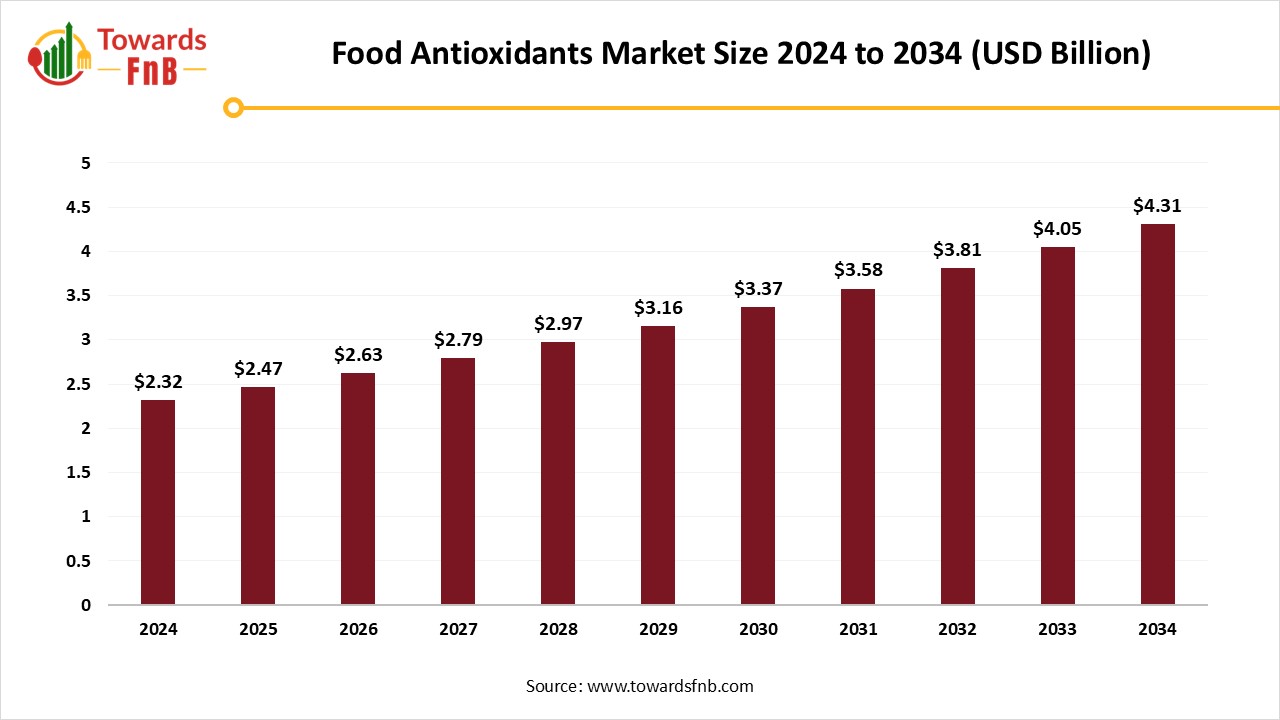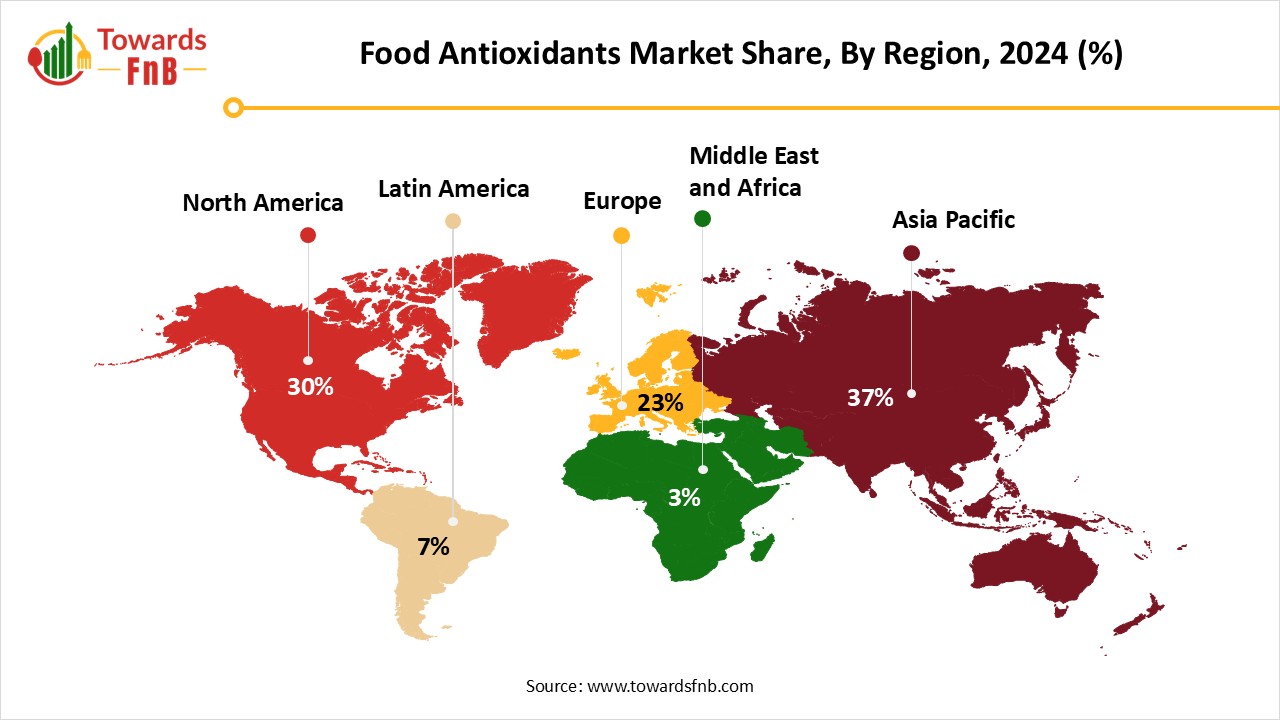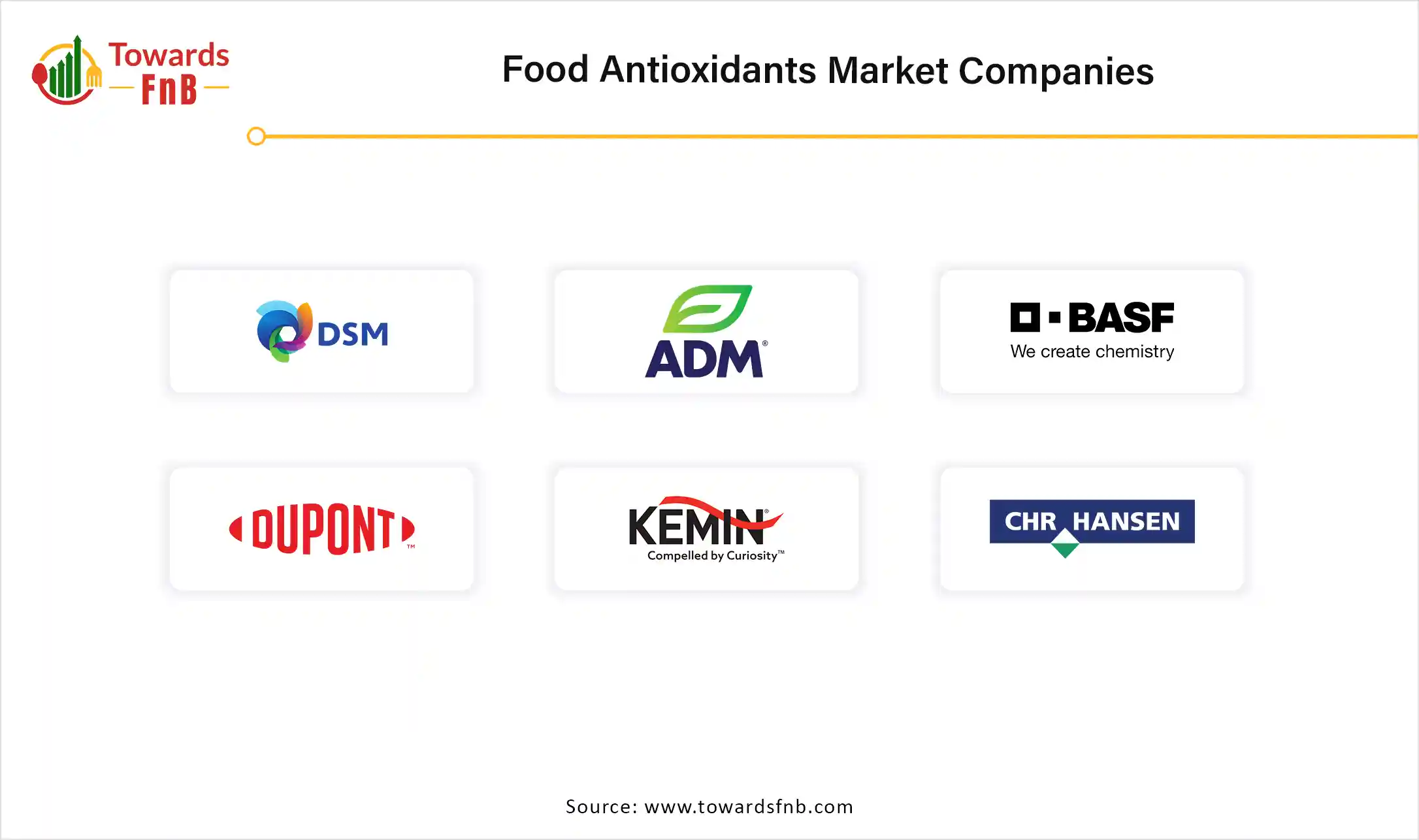December 2025
The global food antioxidants market size was reached at USD 2.32 billion in 2024 and is expected to rise from USD 2.47 billion in 2025 to nearly USD 4.31 billion by 2034, growing at a CAGR of 6.4% during the forecast period from 2025 to 2034. The excellent roles of antioxidants and other bioactive compounds in improving the overall health and wellness of the global population accelerate their global demand in the market.

| Study Coverage | Details |
| Growth Rate from 2025 to 2034 | CAGR of 6.4% |
| Market Size in 2025 | USD 2.47 Billion |
| Market Size in 2026 | USD 2.63 Billion |
| Market Size by 2034 | USD 4.31 Billion |
| Largest Market | Asia Pacific |
| Base Year | 2024 |
| Forecast Period | 2025 to 2034 |
| Regions Covered | North America, Europe, Asia-Pacific, Latin America, and Middle East & Africa |
Food antioxidants are natural or synthetic compounds added to food products to prevent oxidation, thereby extending shelf life and maintaining nutritional quality and flavor. They inhibit or delay the oxidation of fats, oils, and other ingredients, preventing spoilage and rancidity. These antioxidants play a crucial role in preserving food freshness, enhancing food safety, and improving overall product quality in the food and beverage industry.
The antioxidants can be used to slow down lipid oxidation and improve color stability. They can also be used to delay the development of unpleasant flavors in meat products. The meat industry also prefer a high use of natural antioxidants. There is significant progress in the research and development of plant-based food industries to understand their health benefits.
The shelf life of meat products can be decreased due to lipid oxidation. The use of synthetic antioxidants is considered unhealthy since natural antioxidants are healthy alternatives. To achieve the goals of the meat, dairy, food, and beverage industries, improvements in existing technologies are necessary to expand the new innovations.
How Asia Pacific Dominated the Food Antioxidants Market in 2024?
Asia Pacific dominated the food antioxidants market in 2024 and is observed to sustain the position during the forecast period. The development of the food processing sector and the faster adoption of technologies fostered the growth of this region. The growing awareness of consumers regarding their healthy food choices and the impact of conventional agriculture practices on the environment and animals are also the major rationales behind the regional success. The Asian Pacific countries, like India, are the biggest growing economy in the world among other developing economies.
How has India Achieved Progress towards the Food Processing Sector?
Millions of Indians prefer a proper plant-based diet including dairy products. The popularity of plant-based food among the Indian population has raised its production across the food processing industry. The plant-based alternatives provide similar benefits to dairy or meat products. Indian culture is rooted in more sustainable, healthier, and consumer-friendly food and beverage products.

How North America Proved itself as a Significantly Growing Marketplace in the Food Antioxidants Market?
North America is seen to be a significantly growing region in the food antioxidants market during the forecast period. In May 2024, the U.S. Department of Agriculture (USDA) announced the investment of $30.8 million to advance research and expand capacity across 1890 historically black land-grant universities. The Organic Transition Initiative of the USDA provides several programs and resources to boost organic farmers for organic farming.
How is the U.S. Advancing in Research, Innovations, and Organic Transition?
The USDA introduced new programs and partnerships and also announced investments to establish and expand the organic food market. In May 2024, Agriculture Secretary Tom Vilsack of Washington DC, announced the $10 million in funding to expand the market reach of organic products. It will also help producers to raise their organic production. The National Institute of Health (NIH) takes initiatives to expand nutrition research.
How Natural Antioxidants Segment Dominated the Food Antioxidants Market in 2024?
The natural antioxidants segment dominated the food antioxidants market with an estimated share of ~60-65% in 2024. The various types of antioxidants, such as vitamin A, C, E, nutrient antioxidants, minerals, zinc, copper, selenium, etc. present in certain foods have the potential to reduce some of the damage caused by free radicals. The greater antioxidant effects are also offered by phytochemicals in plants rather than vitamins and minerals. The good sources of antioxidants include anthocyanins, catechins, flavonoids, polyphenols, etc. while plant foods are rich sources of antioxidants. The plant foods are rich in vegetables, fruits, and other foods, including wholegrains, meats, fish, nuts, and poultry. A diet rich in disease-fighting antioxidants helps to reduce the risk of certain types of cancer and heart diseases.
Under natural antioxidants, the polyphenols is seen to grow rapidly as a sub-segment in the market during the predicted timeframe. Several types of polyphenols exhibit strong antifungal, anti-inflammatory, and antibacterial properties. A wide range of polyphenolic compounds, including phenolic acids, flavonoids, stilbenes, and lignans, are beneficial for health in providing better blood sugar control, lower risk of heart disease, skin protection, gut health, and enhanced cognitive performance.
What made Bakery and Confectionery the Dominant Segment in the Food Antioxidants Market in 2024?
The bakery and confectionery segment dominated the food antioxidants market with an estimated share of 30-35% in 2024. The use of natural antioxidants in bakery products results in enhanced shelf-life of those products. There is an increasing demand for the use of natural antioxidants in bakery and confectionery to prevent any carcinogenic, mutagenic, or toxigenic effects of synthetic antioxidants. The use of α-tocopherol, β-carotene, and ascorbic acid as natural antioxidants in bakery is preferred to enhance the shelf-life of products. The use of techniques such as encapsulation of antioxidants helps to retain the activity of these compounds. Some of the plant extracts such as vanillin, curcumin, mint, and garcinia also exhibit antioxidative activities.
The meat and poultry products segment is expected to grow at the fastest CAGR in the market during the forecast period. The natural antioxidants in meat and poultry products function in chelating metal ions, and inhibiting lipid peroxidation and oxidative chain reactions. Research studies suggest that several natural extracts such as oregano, pomegranate, rosemary, green tea, etc. help in slowing down oxidation in meat products by maintaining product safety and sensory quality.
How did the Powder Segment Dominate the Food Antioxidants Market in 2024?
The powder segment dominated the food antioxidants market with an estimated share of 50% in 2024. A wide range of antioxidant-rich ingredients in powder form are rich in vitamin C, flavonoids, polyphenols, anthocyanin, betacyanin, and other essential compounds. These antioxidant-rich ingredients in powder form include Baobab Powder, Acerola Powder, Pineapple Powder, lemon powder, and some others which provide vitamin C benefits to consumers. These powdered forms offer enhanced stability, the potential for targeted delivery, and ease of mixing into various products. The fruit powders, vegetable powders, seed powders, herbal powders, and extract powders are rich in offering antioxidative activity. They provide benefits such as increased bioavailability, the potential for reduced waste, and convenient consumption.
The liquid segment is expected to grow at the fastest CAGR in the food antioxidants market during the predicted timeframe. The antioxidant-rich drinks protect the human body from oxidative stress, improve cardiovascular health, reduce the risk of certain cancers, and support overall health. These antioxidant-rich drinks such as fruit juice, vegetable juices, green tea, herbal tea, and coffee result in improved nutrient absorption and enhanced bioavailability.
How Plant-based Segment Dominated the Food Antioxidants Market in 2024?
The plant-based segment dominated the food antioxidants market with an estimated market share of 30-35% in 2024. The plant-based antioxidants provide several benefits, such as reduced inflammation, improved cognitive function, enhanced immunity, healthy aging, and prevention of cancer. The choice of whole foods, plenty of green vegetables, and colorful fruits and avoiding unhealthy snacks benefit consumers with good health and wellness. Replacing an unhealthy diet with antioxidant-rich options like seeds, nuts, berries, and dark chocolate avoids the risk of developing diseases. The intake of antioxidant-rich beverages like green tea, black tea, and herbal tea provide good hydration to the body and a potent dose of antioxidative effects. The incorporation of herbs and spices such as oregano, turmeric, ginger, and cinnamon into cooking enhances the nutritional value of meals.
The microbial-based segment is expected to grow at the fastest CAGR in the market during the forecast period. Microorganisms are a rich source of antioxidants and bioactive compounds, which includes the production of phenolic compounds which are naturally produced as potential compounds. Natural compounds from microbes are considered as safe alternatives for industrial applications.
What made Food Processing Industry the Dominant Segment in the Food Antioxidants Market in 2024?
The food processing industry segment dominated the food antioxidants market with an estimated share of 55% in 2024. The most powerful food additives used in the food processing industry are antioxidants, which can be present in natural or synthetic forms. They are widely used in fats and oils, which help to enhance the shelf-life and appearance of many industrial food and beverage products. Food processing is carried out to achieve the safety and quality of products by various processes. Food processing offers more soluble products than synthetics, and products with added value as healthier and natural alternatives. The use of additives allows efficient industrial product manufacturing.
The dietary supplements segment is expected to grow at the fastest CAGR in the market during the predicted timeframe. A proper diet and natural dietary supplementation prevent the risk of developing non-communicable diseases such as diabetes, cancer, hypertension, obesity, and cardiovascular diseases. Dietary supplements help with disease prevention, resolve oxidative stress, improve eye health, and offer cognitive benefits.
BASF SE
DuPont de Nemours

By Type
By Application
By Form
By Source
By End-Use
By Region
The U.S. pet food market size is projected to witness strong growth from USD 45.39 billion in 2025 to USD 66.88 billion by 2034, reflecting a CAGR of ...
December 2025
December 2025
December 2025
December 2025